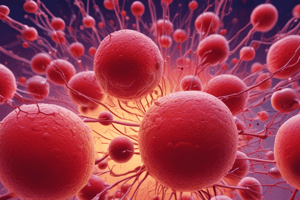Podcast
Questions and Answers
What is the role of platelets in blood clotting?
What is the role of platelets in blood clotting?
Platelets are involved in blood clotting and forming scabs where the skin has been cut or punctured.
How do phagocytes defend against infection?
How do phagocytes defend against infection?
Phagocytes carry out phagocytosis by engulfing and digesting pathogens.
What is the main function of lymphocytes in the immune system?
What is the main function of lymphocytes in the immune system?
Lymphocytes produce antibodies to destroy pathogenic cells and antitoxins to neutralize toxins released by pathogens.
How do phagocytes appear under a microscope?
How do phagocytes appear under a microscope?
What is the purpose of scab formation in wound healing?
What is the purpose of scab formation in wound healing?
How do lymphocytes differ from phagocytes in terms of their appearance?
How do lymphocytes differ from phagocytes in terms of their appearance?
Explain the role of platelets in the blood clotting process.
Explain the role of platelets in the blood clotting process.
What is the primary function of the blood clot formed during the clotting process?
What is the primary function of the blood clot formed during the clotting process?
Describe the process of scab formation and its significance.
Describe the process of scab formation and its significance.
Explain the role of red blood cells in the blood clotting process.
Explain the role of red blood cells in the blood clotting process.
What is the significance of the solubility change of fibrinogen during the blood clotting process?
What is the significance of the solubility change of fibrinogen during the blood clotting process?
Describe the role of plasma in the blood clotting process.
Describe the role of plasma in the blood clotting process.
Explain the key function of red blood cells and how their structure enables this function.
Explain the key function of red blood cells and how their structure enables this function.
Describe the role of white blood cells in the body's immune response.
Describe the role of white blood cells in the body's immune response.
What is the primary function of plasma, and name three key components it contains.
What is the primary function of plasma, and name three key components it contains.
Explain the mechanism by which platelets initiate blood clotting and their importance.
Explain the mechanism by which platelets initiate blood clotting and their importance.
Describe the sequence of events that occur during the blood clotting process, starting from vascular injury.
Describe the sequence of events that occur during the blood clotting process, starting from vascular injury.
How do the functions of red blood cells, white blood cells, and platelets interrelate in maintaining homeostasis?
How do the functions of red blood cells, white blood cells, and platelets interrelate in maintaining homeostasis?
Flashcards are hidden until you start studying




